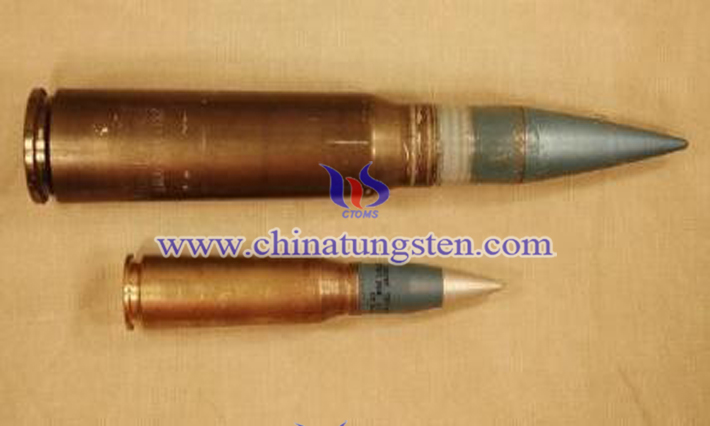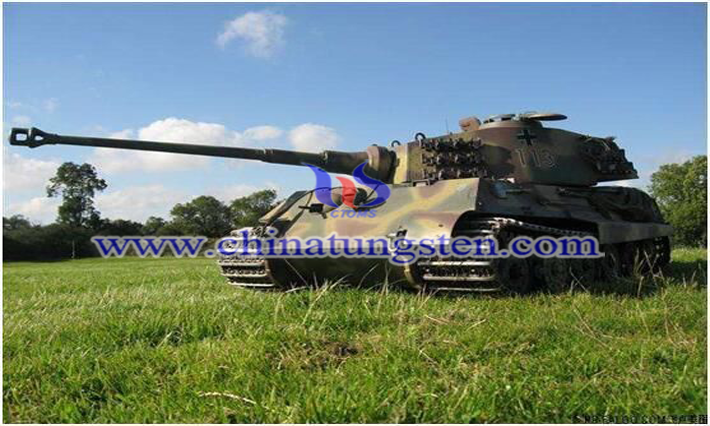Tungsten Alloy Armor Piercing Projectile
- Details
- Category: Tungsten Information
- Published on Monday, 16 August 2021 16:51
Tungsten Alloy Armor Piercing Projectiles rely on the action of high-temperature and high-pressure gas in the bore to obtain great initial kinetic energy to penetrate tank armor and destroy its internal system.
Traditional armor piercing projectile is a projectile which mainly relies on the powerful kinetic energy of warhead to forcibly penetrate armor and destroy the target. It contains a small amount of explosives and fuses in the projectile body. Although the projectile head has broken during impact, the projectile body still has strong inertia, so it will continue to forward. When the impact force reaches a certain value, the fuse is triggered and ignited, which causes the explosion of the projectile charge. At this time, in every square centimeter area, tens to hundreds of tons of high pressure can be generated, thus killing the occupants in the tank and destroying weapons and equipment.

Compared with the traditional armor piercing projectile, the tungsten alloy armor piercing projectile is not filled with explosives, but changed into a tungsten alloy core, which obtains great initial kinetic energy under the action of high-temperature and high-pressure gas in the bore, and competes with the tank armor for hardness. After piercing armor, people in armored targets are killed and equipment is destroyed by high-speed splashing armor fragments and armor-piercing bullet core fragments.
Under the conditions of 125mm caliber main gun and 2000m shooting distance equipped with ZTZ99G/99 main battle tank of our army: using ordinary shelling armor piercing projectile, it can penetrate 800mm homogeneous steel armor; Using ordinary armor-piercing projectile, 580mm homogeneous steel armor can be penetrated. Therefore, under the same conditions, the power gap between tungsten alloy armor piercing projectile and traditional armor piercing projectile is at least 1.38 times.
The armor piercing projectile will generate a lot of heat when it rubs against the air in flight. If the filler in the armor piercing projectile is not hot, it will stick together and cannot achieve the function of piercing armor. Tungsten alloy penetrator core is a high specific gravity tungsten alloy product with high density, excellent thermal stability and high cross-section density, which is beneficial to control missile flying at high altitude.

To sum up, it is necessary for traditional armor piercing projectiles to gradually transition to tungsten alloy armor piercing projectiles because: (1) Tungsten alloy armor piercing projectiles have high specific gravity and high density. Its density can reach 18g/cm3, which is 2.3 times of the specific gravity of steel (7.8g/cm3), so the section density of the bullet core is large, which is beneficial to improve the speed-storing ability and penetration ability of steel plates during flight, and provides the possibility for improving the kinetic energy of armor piercing projectile to strike the armor fatally. (2) Tungsten alloy has high temperature resistance and good thermal stability, which generates a lot of heat by friction with air during the flight of armor piercing projectile. If the filler in armor piercing projectile has poor thermal property, it will be bonded together and cannot achieve the function of armor-piercing. This characteristic of tungsten alloy makes armor-piercing projectile play its due role well.
- Tungsten Alloy Manufacturer & Supplier, Chinatungsten Online: www.tungsten-alloy.com
- Tungsten News & Prices of China Tungsten Industry Association: www.ctia.com.cn
- Molybdenum News & Price: news.molybdenum.com.cn
- Tel.: 86 592 5129696; Fax: 86 592 5129797; Email: sales@chinatungsten.com



 sales@chinatungsten.com
sales@chinatungsten.com